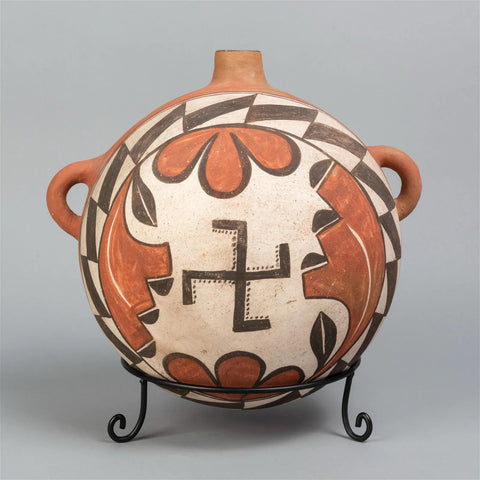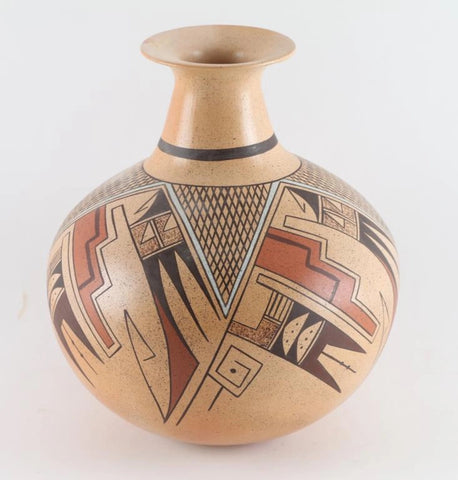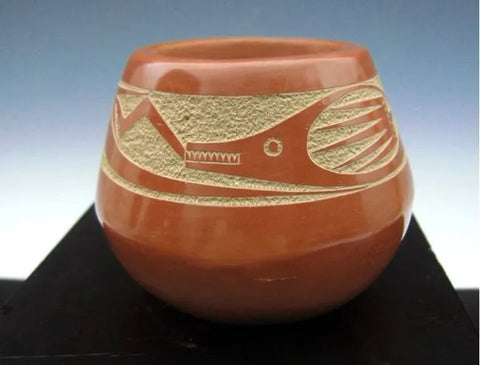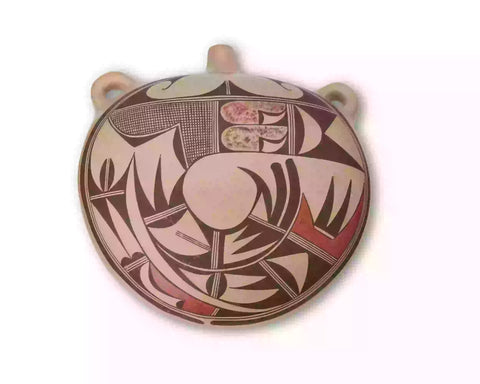
Hopi Pottery : Native American Hopi Polychrome Jar by Fannie Polacca Nampeyo 388 b.
$ 2,750.00
Hopi Pottery
388 b.Native American Hopi Polychrome Jar by Fannie Polacca Nampeyo. Jar decorated with her four-direction eagle tail: signed on the base, height 4 " x diameter 5 ". Near perfect condition for its age.
Fannie Nampeyo (1900-1987) (also known as Fannie Lesou Polacca and Fannie Nampeyo Polacca) was a modern and contemporary fine arts potter, who carried on the traditions of her famous mother, Nampeyo of Hano, the grand matriarch of modern Hopi pottery.
Early life: Fannie was the youngest, and perhaps the most famous, of Nampeyo of Hano's three daughters.[1] She was born in the Hopi-Tewa Corn Clan home atop First Mesa, on the Hopi Reservation in Arizona. Fannie was initially given the name Popongua or Popong-Mana (meaning "Picking Pinons") by the older women of her father Lesou's family, and either missionaries or health-care workers later gave her the name "Fannie."
In the early 1920s she married Vinton Polacca and shortly thereafter, pottery making became an important part of Fannie's life. She increasingly worked with her mother Nampeyo, whose eyesight was diminishing due to trachoma. Fannie helped her mother with pottery painting and decorating, and also assisted her father with polishing. Early works created by Fannie and her mother were signed simply "Nampeyo" by Fannie, since Nampeyo could not read or write, but later they began signing pieces made together as "Nampeyo Fannie." Pieces made solely by Fannie were signed "Fannie Nampeyo" and usually included a drawn corn symbol.
Pottery:Fannie was a prolific potter from 1920-1987 and earned a reputation as an outstanding potter during her lifetime. Her styles included black and red on yellow and black on yellow in the form of jars, cups and saucers. She also made miniatures and bird effigy bowls. Among her favorite designs were clouds, rain, feathers, stars and migrations motifs. In addition to making pottery she also made quilts.
Fannie's pottery won a first place blue ribbon in the "Hopi Show" at the Museum of Northern Arizona in July 1961, and her works have been included in collects by the University of Oklahoma's Fred Jones Jr. Museum of Art[2] and The Cleveland Museum of Art.[3]
Personal: Fannie became matriarch of the Hopi-Tewa Corn Clan, as her mother Nampeyo had been before her. "Nampeyo" is actually the ceremonial title used by the matriarch of the Hopi-Tewa Corn Clan. Fannie and her husband Vinton were among one of the first families at First Mesa to join The Church of Jesus Christ of Latter-day Saints. All seven of Fannies's children (Thomas Polacca, Elva Nampeyo, Tonita, Iris Youvella, Leah, Harold and Elsworth) excelled at pottery making, which they learned from their mother, and several have become known in their own right among collectors of Native American pottery. she died in a car accident in the year of 1987.
Notes
1. Jump up ^ Fannie Polacca Nampeyo (1900-1987)
2. Jump up ^ Fred Jones Jr. Museum of Art: Collections Native American Art
3. Jump up ^ Cleveland Museum of Art - Fannie Nampeyo (American, c. 1860 - 1942)
References
‰ۢ http://www.holmes.anthropology.museum/southwestpottery/fannienampeyo.html
‰ۢ http://www.knoxnews.com/kns/lifestyles_columnists/article/0,1406,KNS_337_5010585,00.html
‰ۢ http://www.eindianjewelry.com/?page=info.php&view=nampeyo
Further reading
‰ۢ AskART.com Inc., Dunbier, Lonnie Pierson (Editor) - The Artists Bluebook. 2005
‰ۢ Mary Ellen and Lawrence Blair - The Legacy of Master Potter Nampeyo and Her Descendants. 1999.
‰ۢ Schaaf, Gregory - Hopi-Tewa Pottery: 500 Artist Biographies. 1998.
‰ۢ Blair, Mary Ellen; Blair, Laurence R. (1999). The Legacy of a Master Potter: Nampeyo and Her Descendants. Tucson: Treasure Chest Books. ISBN 1-887896-06-6. OCLC 41666705. (Source Wikipedia)
‰ۢ Oman, Richard G. (1992), "Artists, Visual", in Ludlow, Daniel H, Encyclopedia of Mormonism, New York: Macmillan Publishing, pp. 70-73, ISBN 0-02-879602-0, OCLC 24502140 (Source: Wikipedia)




